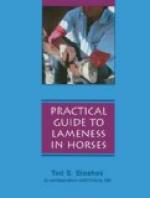Prognosis and Treatment.—In the majority of instances, when there is occasioned serious inconvenience, the outcome is not likely to be favorable, according to Moeller. Detachment of a portion of the thrombus, according to Hoare, may result in the lodgment of an embolus in the brain or kidneys. The latter authority also states that muscular atrophy may occur owing to lack of blood supply in some of these cases. Moeller states that moderate exercise or work stimulates the establishment of collateral circulation. Massage per rectum is condemned as dangerous by Cadiot.
Fracture of the Patella.
Etiology and Occurrence.—Patellar fractures are rarely met with in the horse but may be caused by falls and heavy contusions. Violent muscular contraction, it is said, may also bring about the same condition.
Symptomatology.—Fracture may be transverse or vertical, and depending on the manner in which the bone is broken, prognosis is either at once rendered favorable or unfavorable. The patella performs a function which is in a way similar to that of the sesamoids and when fractured, complete recovery is improbable in the average instance. When complete, transverse fractures permit of separation of the parts of bone. Tension on the straight ligaments below and contraction of the quadriceps above usually cause insuperable difficulty in the handling of this type of fracture in the horse.
Compound fractures as well as multiple or comminuted fractures occasionally occur and these constitute injuries which are generally considered fatal, although Andrien, according to Cadiot and Almy, succeeded in obtaining complete recovery in a case of compound fracture of the patella and the horse was in service and almost free from lameness two months after treatment was begun.
No difficulty is encountered in recognizing the fracture of the patella because of the exposed position of the bone. Crepitation, and in some cases fissures, may be easily detected.
Treatment.—In simple fracture, when treatment is thought advisable, the subject is put in a sling and kept as nearly comfortable as possible. If little inflammation exists, the application of a vesicant two or three weeks after the injury has been inflicted will be helpful and serve to hasten repair.
Bandages or mechanical appliances are of no practical use in the handling of these cases.
Luxation of the Patella.
Etiology and Occurrence.—This, the most common luxation met with in the equine subject, has been described by writers as existing in many forms. Patellar disarticulation may be more practically considered as momentary and fixed, regardless of the position taken by the patella. Described under the title of false luxation are recorded cases wherein the quadriceps (crural) muscles become contracted in such manner that a condition simulating true disarticulation of the patella obtains. Also, some practictioners report cases of patellar luxation and refer to pseudo-luxations, without clearly defining the conditions which constitute pseudo-luxation. This has contributed to the extant cause of misconception as to actual differences between luxation and conditions simulating dislocation.




